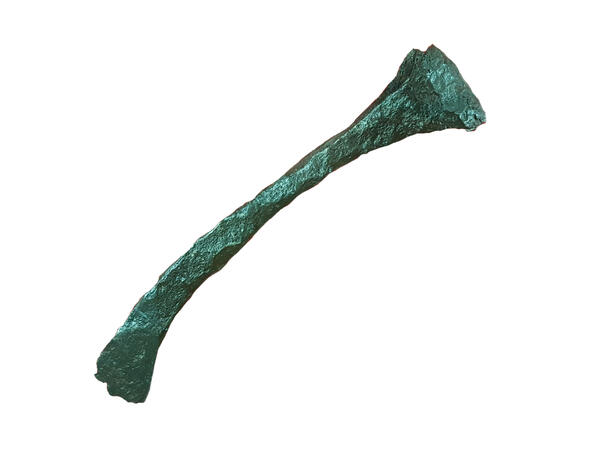The Kursk Museum of Archaeology keeps an axe for wild beekeeping — the main tool that was used when working on obtaining wild honey from bees. It was accidentally discovered on the territory of the modern Belovo district, Kursk region.
The tool is an axe with an eye for a handle and a narrow blade, which was twice the length of logging and fighting axes. Moreover, the find from the Belovo area has an arc-shaped curvature typical of such a tool, with a widening in the sharpened chopping part. The axe is dated from the end of the 10th to the 11th centuries. Such long-bladed axes were mainly used for hollowing out borti (wild hives) — special cavities in wood into which a swarm of bees would be enticed.
Wild beekeeping was a major occupation of the population of the Severian tribal union (Romenskaya archaeological culture) in the basins of the Desna, Sula, Psel, Vorskla and the upper Seversky Donets rivers in the 8th–10th centuries. Ancient Russian written sources use various terms, connected with this craft: “bort” (wild hive), “zemlya bortnaya” (wild-hive land), “bortnye ukhozhai” (wild-hive woods), “forests bortnye” (wild-hive forests), “oak stumps bortnye” (wild-hive oak stumps), “bortnye” villages and hamlets, “bortniki” (wild-hive beekeeper). Wild beekeeping produced honey, which in those old times substituted sugar. Ancient texts referred to honey as a sweet spice for pancakes and porridge. Another product of wild beekeeping is wax. It was mainly used to make candles and also to make plasters and ointments.
The prominent archaeologist and Slavist Artemiy Vladimirovich Artsikhovsky noted that the most common trees used for wild hives were pine, oak or linden. It took an average of one to two weeks to make artificial wild hives. The revamping and cleaning of old hollows took a day or two, or even longer. The process of extracting honey was quite complicated: one had to make a hole with a drill, a thin saw and a chisel. As it is not often that natural hollows are convenient for bees, researchers believe that craftsmen made artificial beehives both in the form of artificial hollows on trees and in the form of logs, which were raised on trees with a special wheel and axle or windlasses. The logs were raised high up on the tree because bees do not like to live low, and also to protect honey from bears. The hives raised on a tree were placed on branches or on a special platform, covered with birch bark and bast to protect them from rain and snow. Scarecrows, rattles and bells were used to scare away bears and birds.
The tool is an axe with an eye for a handle and a narrow blade, which was twice the length of logging and fighting axes. Moreover, the find from the Belovo area has an arc-shaped curvature typical of such a tool, with a widening in the sharpened chopping part. The axe is dated from the end of the 10th to the 11th centuries. Such long-bladed axes were mainly used for hollowing out borti (wild hives) — special cavities in wood into which a swarm of bees would be enticed.
Wild beekeeping was a major occupation of the population of the Severian tribal union (Romenskaya archaeological culture) in the basins of the Desna, Sula, Psel, Vorskla and the upper Seversky Donets rivers in the 8th–10th centuries. Ancient Russian written sources use various terms, connected with this craft: “bort” (wild hive), “zemlya bortnaya” (wild-hive land), “bortnye ukhozhai” (wild-hive woods), “forests bortnye” (wild-hive forests), “oak stumps bortnye” (wild-hive oak stumps), “bortnye” villages and hamlets, “bortniki” (wild-hive beekeeper). Wild beekeeping produced honey, which in those old times substituted sugar. Ancient texts referred to honey as a sweet spice for pancakes and porridge. Another product of wild beekeeping is wax. It was mainly used to make candles and also to make plasters and ointments.
The prominent archaeologist and Slavist Artemiy Vladimirovich Artsikhovsky noted that the most common trees used for wild hives were pine, oak or linden. It took an average of one to two weeks to make artificial wild hives. The revamping and cleaning of old hollows took a day or two, or even longer. The process of extracting honey was quite complicated: one had to make a hole with a drill, a thin saw and a chisel. As it is not often that natural hollows are convenient for bees, researchers believe that craftsmen made artificial beehives both in the form of artificial hollows on trees and in the form of logs, which were raised on trees with a special wheel and axle or windlasses. The logs were raised high up on the tree because bees do not like to live low, and also to protect honey from bears. The hives raised on a tree were placed on branches or on a special platform, covered with birch bark and bast to protect them from rain and snow. Scarecrows, rattles and bells were used to scare away bears and birds.



